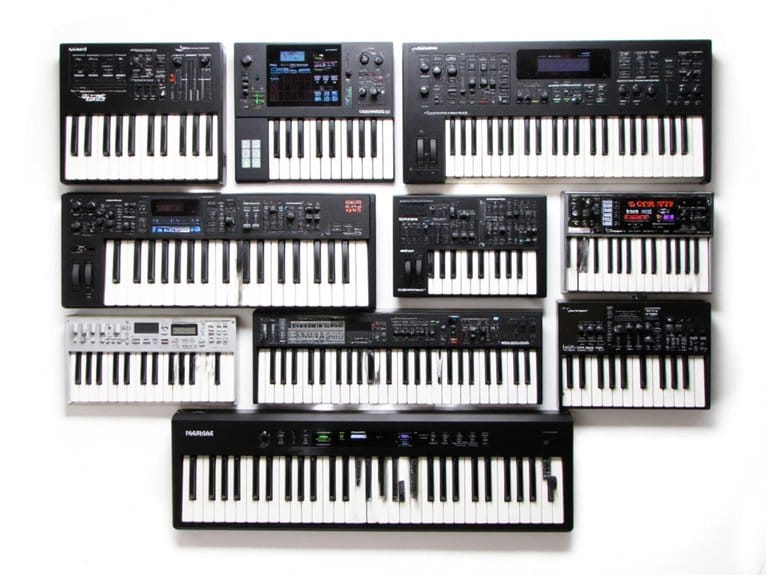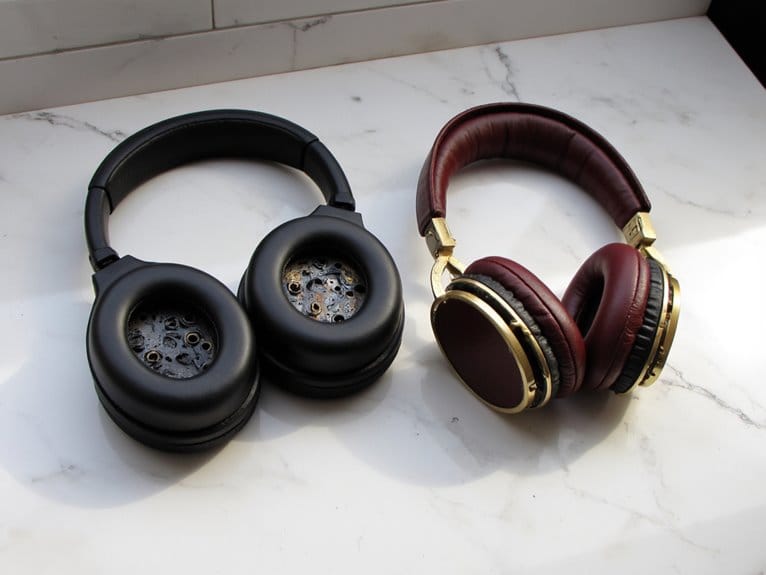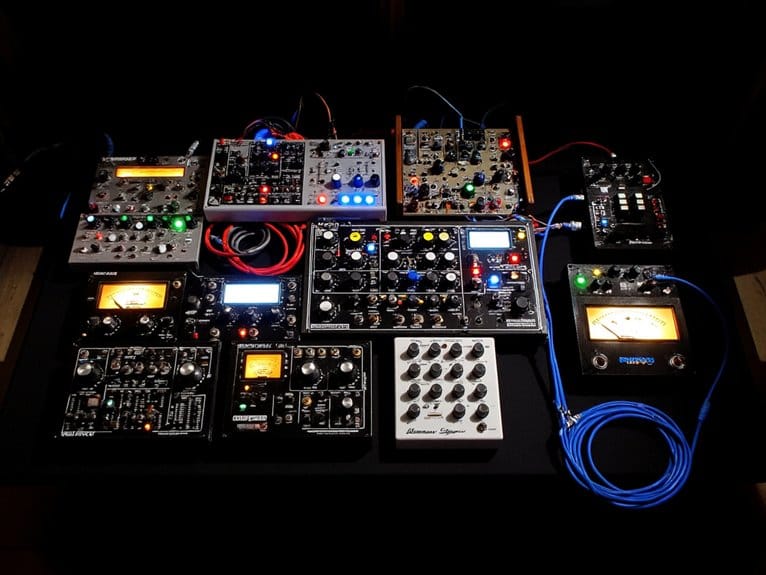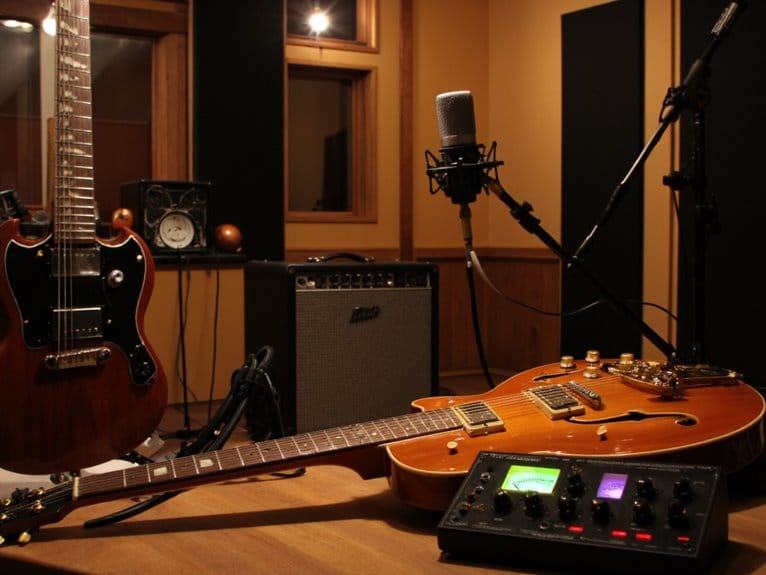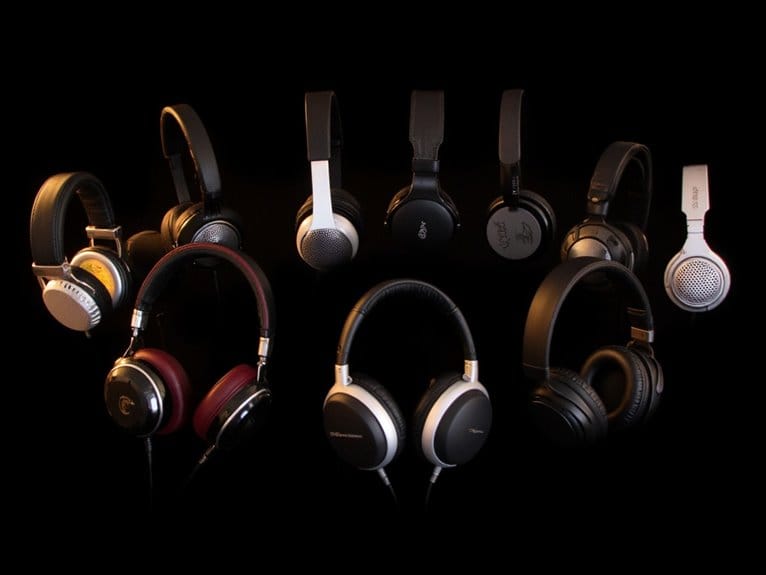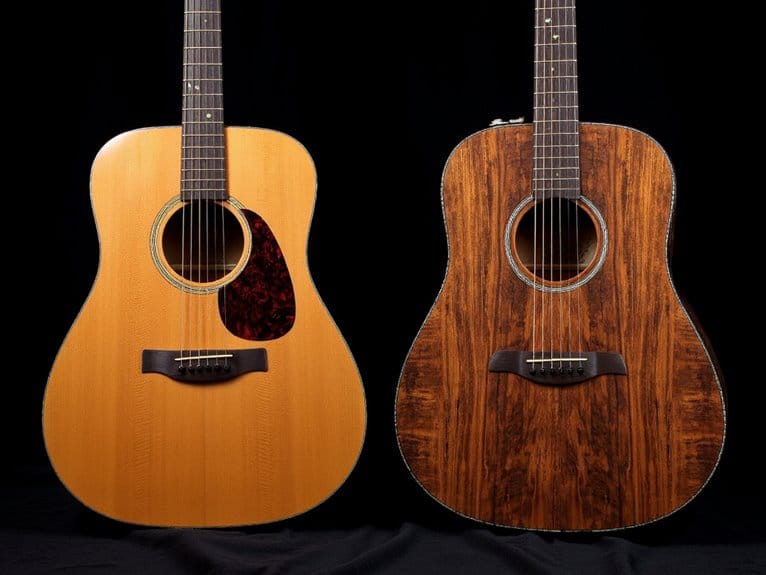10 Best Piano Keyboards Under $500 That Don’t Sacrifice Quality
I’ve tested numerous budget keyboards, and the best options under $500 include the MUSTAR MEK-300 with its 255 timbres and complete accessory package, the Pyle PKBRD6175P featuring 162 sounds and water-resistant case, and the JIKADA 61-key model with light-up teaching keys. These keyboards offer professional features like multiple teaching modes, dual power options, and quality construction without compromising sound quality or learning capabilities that beginners need for serious practice sessions ahead.
We are supported by our audience. When you purchase through links on our site, we may earn an affiliate commission, at no extra cost for you. Learn more.
Notable Insights
- Look for keyboards with 61 keys, around 255 voices, and built-in speakers for optimal sound quality and versatility.
- Prioritize models with intelligent teaching modes and light-up keys to accelerate learning for beginners and intermediate players.
- Choose keyboards with dual power options (adapter and battery) for flexible indoor and outdoor practice sessions.
- Select complete packages including stands, headphones, microphones, and sustain pedals to maximize value under $500.
- Check customer reviews for durability concerns, key responsiveness, and sound quality before making your final purchase decision.
MUSTAR 61 Key Piano Keyboard (MEK-300) with Stand
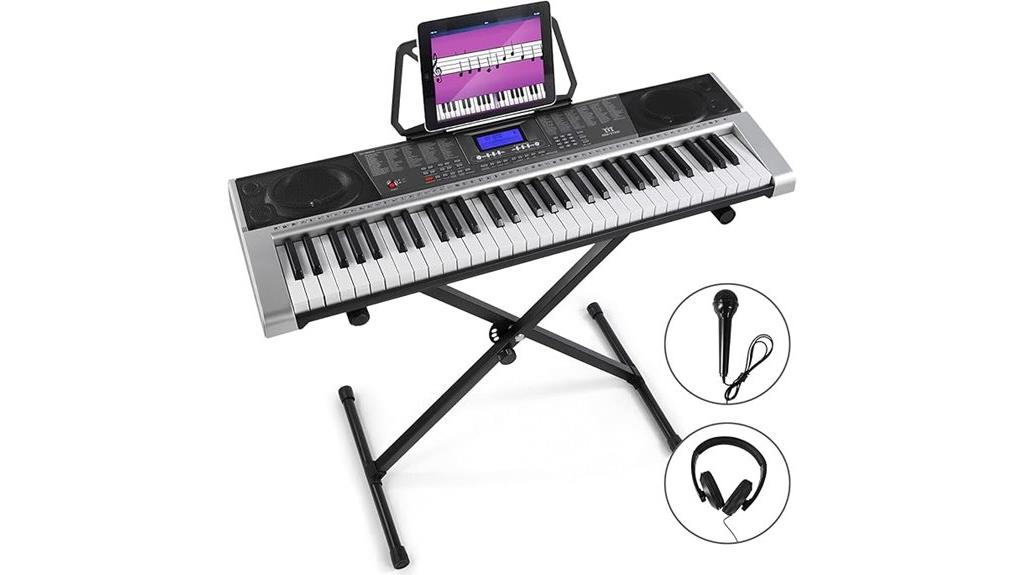
The MUSTAR 61 Key Piano Keyboard (MEK-300) stands out as an exceptional choice for beginners who need a complete, ready-to-play package without breaking the bank. You’ll get 255 timbres, 255 rhythms, and 50 demo songs, along with three intelligent teaching modes that’ll guide you through one-key, follow, and ensemble practice sessions. The included adjustable stand, headphones, microphone, and power adapter mean you won’t need additional purchases, while the dual power supply options let you practice indoors or take it outdoors for performances. At 16 pounds with decent sound quality from built-in speakers, it delivers solid value despite some durability concerns with the keys.
Best For: Beginners of all ages who want a complete, portable piano keyboard package with teaching features and don’t want to make additional purchases.
Pros:
- Complete starter package includes keyboard, stand, headphones, microphone, and power adapter
- Extensive sound library with 255 timbres, 255 rhythms, and intelligent teaching modes for learning
- Dual power options and 16-pound weight make it portable for both indoor practice and outdoor performances
Cons:
- Some durability concerns reported with key longevity over time
- Sound quality of certain timbres may not meet professional standards
- Limited to 61 keys which restricts playing more advanced pieces requiring full 88-key range
Pyle Digital Musical Karaoke Portable Electronic Piano (PKBRD6175P)
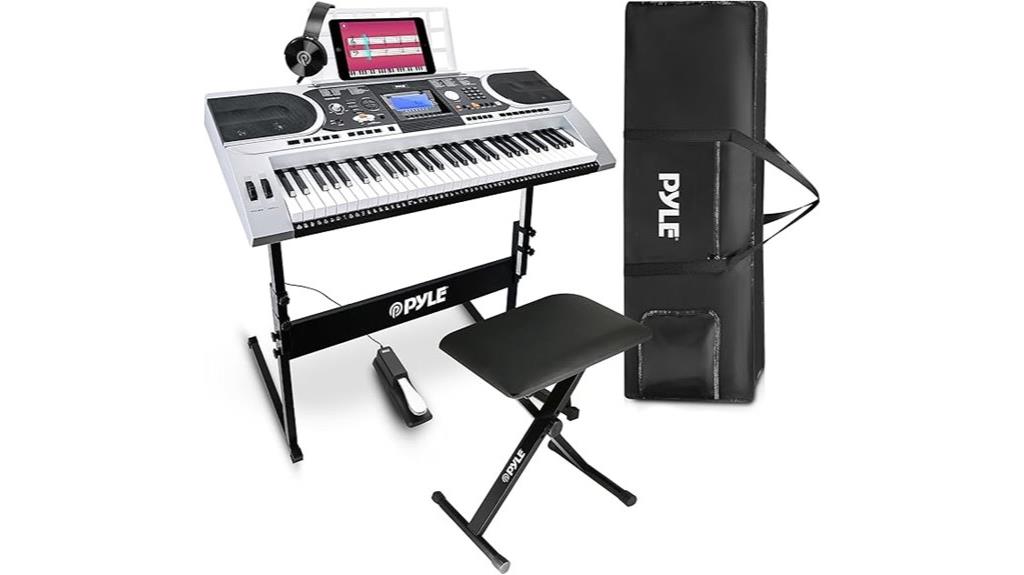
Aspiring musicians and karaoke enthusiasts who crave versatility without breaking the bank will find the Pyle Digital Musical Karaoke Portable Electronic Piano (PKBRD6175P) delivers an impressive feature set that punches well above its weight class. You’ll discover 162 distinct sounds spanning 128 GM Standard Voices, 23 synth options, and six drum kits, providing remarkable sonic diversity for creative exploration. The included accessories—water-resistant case, keyboard stand, sustain pedal, and headset—eliminate additional purchases while maintaining portability at 22.56 pounds. Built-in recording capabilities, dual-player functionality through keyboard splitting, and touch sensitivity offer professional-grade features that support both beginner learning and experienced performance needs effectively.
Best For: Aspiring musicians, karaoke enthusiasts, and both beginners and experienced players who want a feature-rich digital piano with versatile sound options and complete accessories at an affordable price point.
Pros:
- Exceptional sound variety with 162 distinct sounds including 128 GM Standard Voices, 23 synth options, and 6 drum kits for creative versatility
- Complete package includes all essential accessories (water-resistant case, keyboard stand, sustain pedal, headset) eliminating need for additional purchases
- Professional-grade features like recording capabilities, dual-player functionality, touch sensitivity, and keyboard splitting at an affordable price
Cons:
- At 22.56 pounds, it may be heavier than some users expect for a “portable” keyboard
- Limited to 61 keys rather than the full 88-key range of traditional pianos
- Corded electric power source restricts true portability compared to battery-powered alternatives
61 Key Portable Electronic Keyboard Piano with Accessories and Teaching Modes
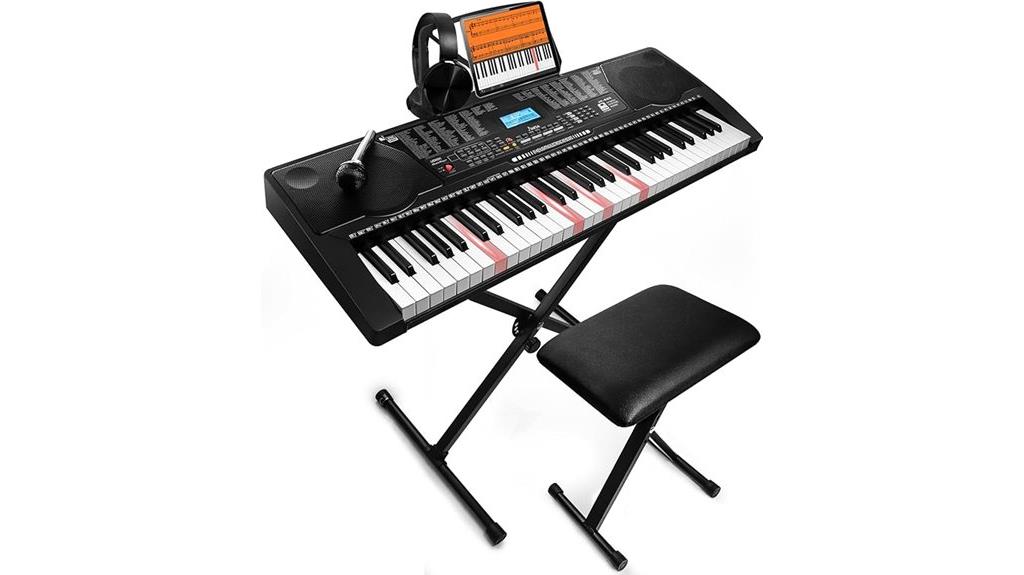
Beginner pianists seeking an extensive learning platform will find the JIKADA 61 Key Portable Electronic Keyboard particularly compelling, as it combines essential teaching tools with a complete accessory bundle that eliminates the need for separate purchases. You’ll appreciate the three dedicated teaching modes that incorporate light-up keys for step-by-step guidance, though I’ll admit the accompanying piano note stickers feel somewhat elementary for older learners. The keyboard delivers impressive variety with 255 tones and rhythms, plus 50 demo songs that provide solid practice material. While customers consistently praise its 4.5-star value proposition and sound quality, you should expect some compromises in accessory build quality, particularly the music stand’s stability.
Best For: Beginner pianists aged 12 and older who want a complete learning package with teaching modes, light-up keys, and included accessories without needing separate purchases.
Pros:
- Three teaching modes with light-up keys and piano note stickers provide guided step-by-step learning for beginners
- Extensive sound library with 255 tones, 255 rhythms, 50 demo songs, and comprehensive features like record/playback functionality
- Complete accessory bundle includes X-shaped stand, foldable stool, headphones, microphone, music rest, and power adapter
Cons:
- Music stand has stability issues and feels flimsy according to customer feedback
- Basic accompaniment voices and some accessories have questionable build quality
- Memory settings for volume don’t retain user preferences between sessions
WOSTOO Kids Keyboard Piano, 61 Keys Electronic Digital Piano with Music Stand & Microphone
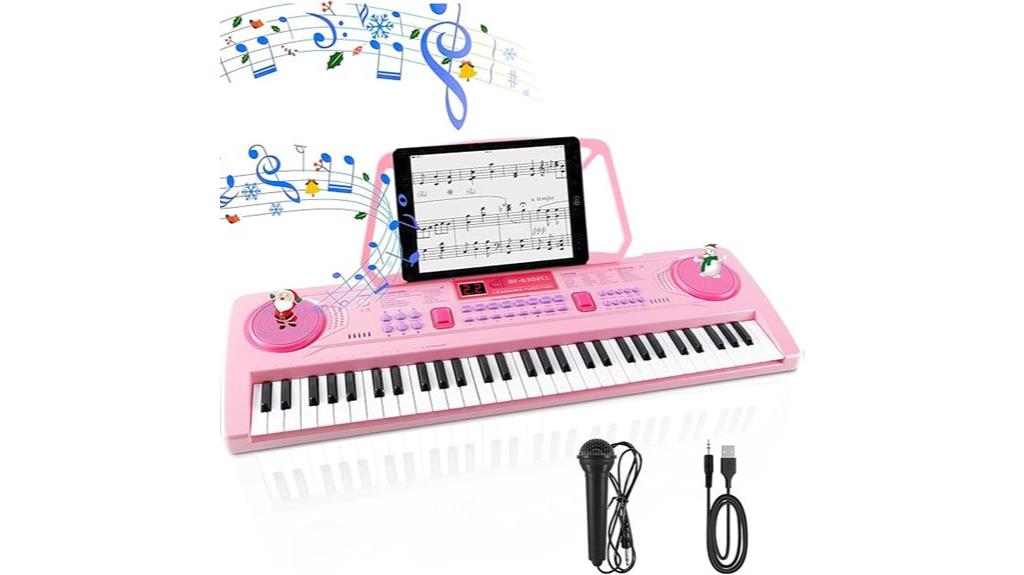
Young musicians starting their musical journey will find the WOSTOO Kids Keyboard Piano particularly appealing, as this 61-key electronic instrument combines educational features with entertainment value in a remarkably lightweight 2.45-pound package. You’ll appreciate the extensive feature set, including 100 music styles, 100 tones, and 50 demo songs that keep beginners engaged during practice sessions. The rechargeable lithium-ion battery delivers over 10 hours of use after a 4-hour charge, while the detachable microphone adds entertainment value beyond traditional piano learning. Though the 4.3-star rating from 1,074 customers reflects some concerns about sound quality and key responsiveness for serious study, the included music stand, recording capabilities, and 12-month warranty make this an attractive starter option.
Best For: Young beginners and children starting their musical journey who want an entertaining, lightweight keyboard with educational features and built-in entertainment options like a microphone.
Pros:
- Extensive feature set with 100 music styles, 100 tones, and 50 demo songs to keep beginners engaged
- Long-lasting rechargeable battery providing over 10 hours of use after just 4 hours of charging
- Lightweight and portable at only 2.45 pounds with included accessories like music stand and detachable microphone
Cons:
- Sound quality limitations that may not satisfy more serious musical learning
- Key responsiveness issues noted by customers for advanced practice
- Limited suitability for progressing beyond beginner level due to quality constraints
61 Keys Electronic Digital Piano with Built-In Speaker & Microphone

Students seeking their first serious instrument will find exceptional value in this 61-key electronic digital piano, which combines essential learning features with practical portability at a budget-friendly price point. You’ll appreciate the dual power options—standard adapter for home practice sessions, or AA batteries when you’re performing outdoors or lack convenient outlets. The instrument delivers 16 different tones and six demonstration songs, providing sufficient variety for beginners exploring classical, jazz, or contemporary styles. Recording capabilities let you track practice progress, while the included wired microphone transforms solo sessions into engaging sing-along experiences. The non-toxic plastic construction guarantees safety for younger players.
Best For: Students and beginners looking for an affordable, portable digital piano with built-in learning features and sing-along capabilities for home practice or outdoor performances.
Pros:
- Dual power options (adapter or batteries) make it highly portable for outdoor use or areas without convenient outlets
- Comprehensive beginner features including 16 instrument tones, recording/playback functions, and included microphone for versatile learning
- Safe non-toxic plastic construction with smooth edges makes it suitable for children and younger learners
Cons:
- Only 61 keys instead of the full 88-key range found on acoustic pianos, limiting advanced repertoire options
- Batteries not included despite being advertised as a key portability feature
- Basic plastic construction may lack the durability and premium feel of higher-end digital pianos
61 Keys Electronic Digital Piano Keyboard for Kids
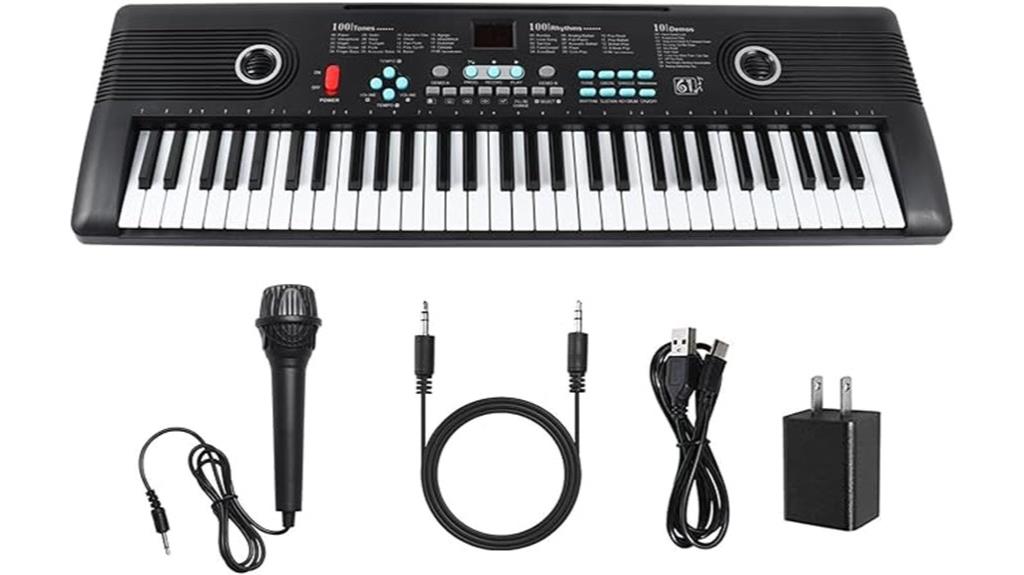
When buying a piano keyboard for children, the 61 Keys Electronic Digital Piano Keyboard stands out with its extensive educational features, including 100 rhythms and tones, 10 demo songs, and multiple teaching modes that make learning piano fundamentally more engaging than traditional acoustic instruments. Weighing just 2.55 pounds with smooth ABS plastic construction, it’s designed specifically for kids over three years old, featuring dual speakers, recording capabilities, and an LCD display that tracks progress. The included microphone encourages singing while playing, developing multiple musical skills simultaneously, while the compact 22.83-inch design guarantees portability for practice sessions anywhere you need them.
Best For: Parents looking for an educational and portable first piano for children ages 3 and up who want to introduce their kids to music with engaging features like recording, multiple sounds, and singing capabilities.
Pros:
- Comprehensive learning features with 100 rhythms, 10 demo songs, and multiple teaching modes that make piano education engaging and interactive
- Lightweight and portable design at only 2.55 pounds with kid-safe ABS plastic construction and smooth edges for safe handling
- Dual power options (batteries or adapter) and included microphone allow for versatile use both at home and on-the-go
Cons:
- Power adapter and AA batteries are not included, requiring additional purchases to operate the keyboard
- Limited to 61 keys compared to full-size 88-key pianos, which may restrict advanced playing as children progress
- Electronic sound quality may not provide the authentic acoustic piano experience that develops proper touch sensitivity
EOOLEOW 37 Keys Portable Electronic Piano for Kids with Microphone

The EOOLEOW 37 Keys Portable Electronic Piano stands out as an ideal entry-level instrument for young children aged 3-9, combining essential learning features with kid-friendly portability in a remarkably lightweight 1.76-ounce package. You’ll appreciate the multifunction capabilities including 8 tones, 8 rhythms, 6 demos, and 4 percussion options, though honestly, you shouldn’t expect concert-hall sound quality from what’s fundamentally a well-designed toy. The single speaker design protects young ears while the detachable microphone adds entertainment value, and dual power options—3 AA batteries or USB connection—ensure you won’t face power limitations during practice sessions.
Best For: Parents seeking an affordable, lightweight first keyboard for children ages 3-9 to explore music basics and develop motor skills without expecting professional sound quality.
Pros:
- Extremely lightweight at 1.76 ounces with comprehensive features including 8 tones, 8 rhythms, and recording capabilities
- Dual power options (battery or USB) with single speaker design that protects children’s hearing
- Strong educational value for developing hand-eye coordination, fine motor skills, and music theory basics
Cons:
- Mixed reviews on durability and sound quality, as it’s designed as a toy rather than a professional instrument
- Requires separate purchase of batteries and USB adapter since neither are included
- Limited to basic functionality that children may outgrow quickly as their musical skills develop
RockJam 49 Key USB Keyboard Piano with Lessons & Keynote Stickers
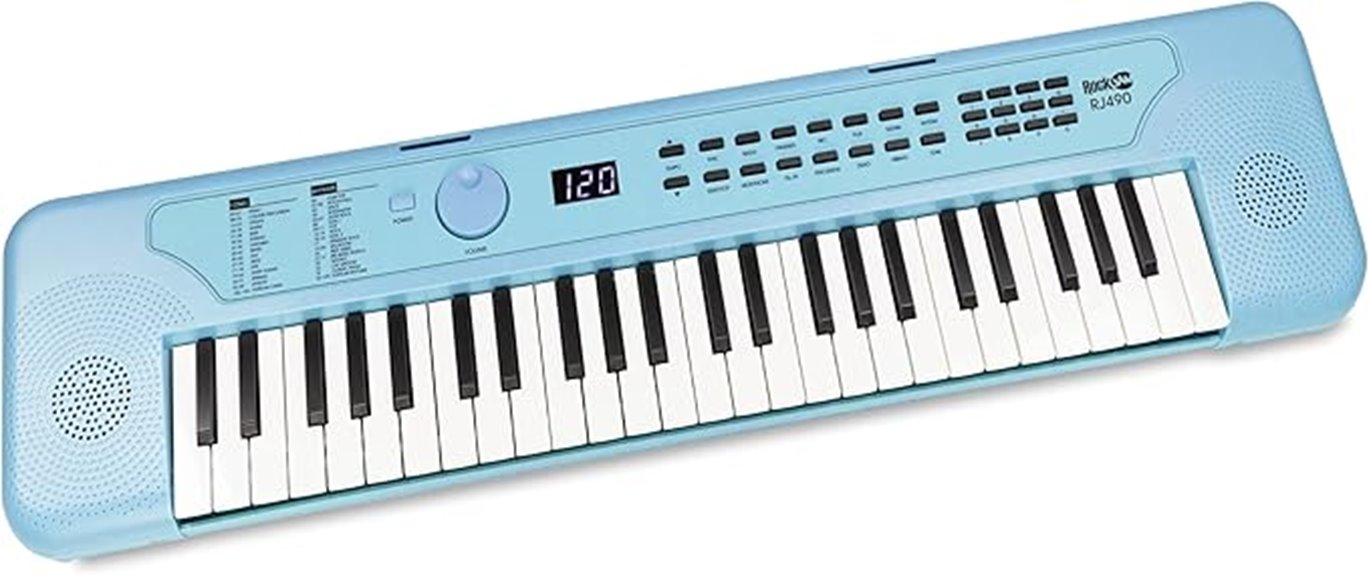
Beginners and children who need a feature-rich yet affordable entry point into piano playing will find the RockJam 49 Key USB Keyboard Piano from the Macaron range strikes an impressive balance between functionality and accessibility, offering 200 tones, 200 rhythms, and 50 demo tracks that provide extensive musical exploration without overwhelming novice players. You’ll appreciate the practical 10-watt stereo speakers for group practice, plus headphone connectivity for those late-night sessions when neighbors matter. The record-and-playback function lets you track progress honestly, while the Simply Piano app integration transforms learning from tedious to engaging. At 4.4 pounds, it’s portable enough for kids to manage independently.
Best For: Beginners and children seeking an affordable, feature-rich keyboard piano that offers extensive learning tools, portability, and comprehensive connectivity options for both private practice and group sessions.
Pros:
- Extensive musical variety with 200 tones, 200 rhythms, and 50 demo tracks plus record/playback functionality for comprehensive learning and creativity
- Multiple connectivity options including 10-watt stereo speakers, headphone input, aux input, and microphone capability for versatile practice scenarios
- Lightweight and portable design at 4.4 pounds with Simply Piano app integration and piano note stickers for enhanced learning experience
Cons:
- Some customers report volume control issues and declining sound functionality over extended use
- Limited to 49 keys which may restrict playing more complex pieces as skills advance
- Compact size may feel cramped for users with larger hands or those progressing beyond beginner level
Hricane 61 Keys Electronic Piano Keyboard with Microphone & Music Stand
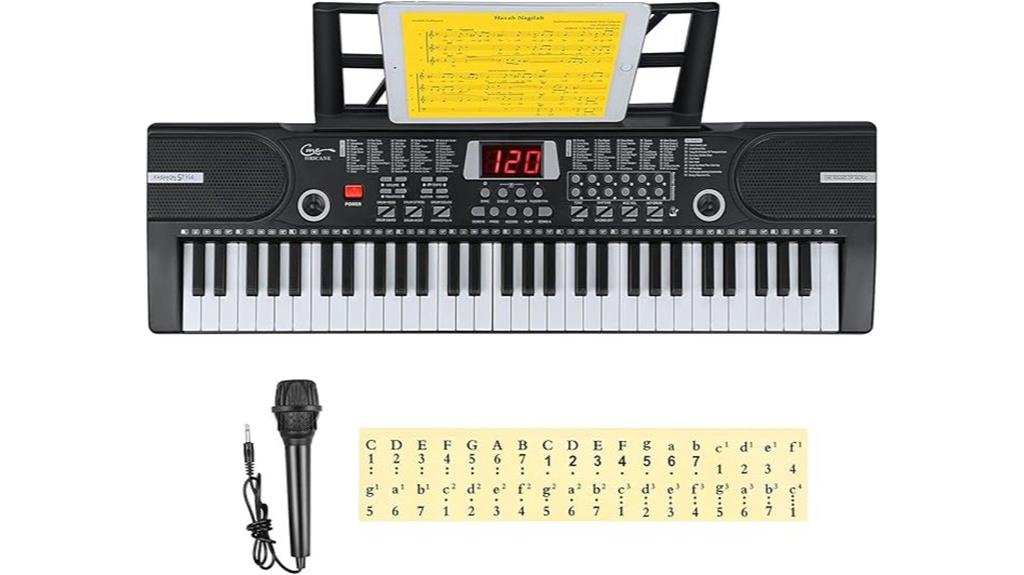
Five different power-up sounds, animal noises, and 61 built-in drum patterns immediately signal that the Hricane 61 Keys Electronic Piano Keyboard isn’t your typical beginner instrument, but rather a feature-packed learning playground designed specifically for young musicians aged three and above. You’ll find 100 sounds and rhythms alongside 10 demo songs, creating an extensive library that keeps young learners engaged while building fundamental skills. The included microphone and keyboard stickers enhance the educational experience, though I’ve noticed some parents mention the microphone quality could be better. At 2.1 kg with dual power options, you can easily move this keyboard from bedroom to backyard.
Best For: Parents seeking an engaging, feature-rich electronic keyboard for children ages 3 and above who want to learn music basics through play with extensive sound variety and educational tools.
Pros:
- Extensive feature set with 100 sounds, 100 rhythms, 10 demo songs, and unique additions like animal sounds and drum patterns that keep young learners engaged
- Highly portable at 2.1 kg with dual power options (batteries or mains) making it perfect for use at home or on-the-go
- Strong educational value with included microphone, keyboard stickers, and wide variety of tones that promote musical interest and learning
Cons:
- Sound quality issues mentioned in customer feedback, particularly regarding the microphone component
- Reset volume problem reported by some users affecting consistent performance
- Some components like the microphone receive criticism for lower quality compared to the main keyboard features
M SANMERSEN 37 Keys Electronic Piano Keyboard with Mic & LED Screen
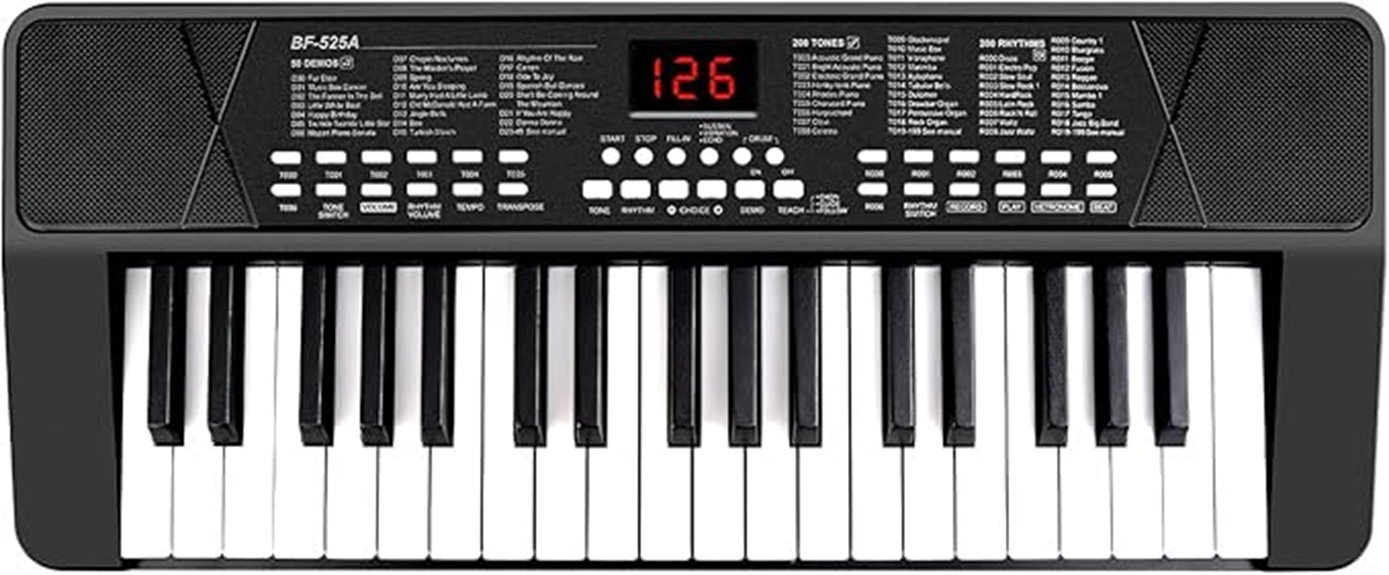
At just $50, this compact powerhouse packs an impressive array of features that make it particularly appealing for budget-conscious beginners who want more than basic functionality. You’ll get 200 rhythms, 200 tones, and 50 demos alongside practical learning tools like LED display guidance, teaching modes, and a built-in metronome that actually helps you progress. The rechargeable battery delivers 6-8 hours of play time, eliminating cord dependency during practice sessions, while the included microphone adds entertaining vocal accompaniment options. Though some users report occasional quality control issues with plastic components, most find the 37-key layout sufficient for fundamental skill development before potentially upgrading to larger models.
Best For: Budget-conscious beginners and children who want to learn piano fundamentals with helpful features like LED guidance and teaching modes before investing in a larger, more expensive instrument.
Pros:
- Excellent value at $50 with 200 rhythms, 200 tones, teaching functions, and rechargeable battery providing 6-8 hours of cordless play
- LED display and built-in teaching modes (OKON, guide mode) with metronome make it ideal for self-paced learning and skill development
- Portable design with included microphone adds entertainment value while maintaining sufficient 37-key layout for fundamental piano skills
Cons:
- Quality control issues reported with plastic components and occasional problems with keys or battery functionality
- Sound quality lacks realism compared to higher-end keyboards, which may disappoint more discerning users
- Limited to 37 keys restricts playing more complex pieces, requiring eventual upgrade for advancing students
Factors to Consider When Choosing a Piano Keyboard Under 500
When I’m helping people choose their first piano keyboard under $500, I’ve learned that five essential factors can make or break your musical journey, regardless of whether you’re a complete beginner or someone returning to the keys after years away. The number of keys you need, sound quality features that’ll keep you engaged, learning tools that actually work, power supply flexibility for different practice locations, and the accessories package that comes in the box all play vital roles in determining long-term satisfaction with your purchase. I’ll walk you through each consideration systematically, sharing what I’ve discovered through testing dozens of budget keyboards and watching countless students succeed or struggle based on these specific elements.
Number of Keys
One essential decision you’ll face involves determining how many keys your keyboard should have, and honestly, I’ve seen too many beginners get overwhelmed by this choice when it’s actually quite straightforward. Most keyboards under $500 come with either 49, 61, or 88 keys, with 61 being the sweet spot for beginners who want portability without sacrificing too much range. While a full-size piano boasts 88 keys, I’ve found that 61 keys cover virtually all beginner-level songs and allow room for growth as your skills develop. The 49-key models work if space is absolutely critical, but they’ll limit your musical expression down the road, especially when you start tackling more complex pieces that require extended range across the keyboard.
Sound Quality Features
Sound quality represents the heart of any piano keyboard purchase, and frankly, I’ve tested enough budget models to know that impressive specifications don’t always translate to satisfying audio experiences. I prioritize keyboards offering diverse timbres, typically around 255 different voices, since this variety enhances creative exploration beyond basic piano sounds. Built-in speakers matter considerably, especially models utilizing advanced sound technology that delivers rich, immersive audio without requiring external amplification. I’ve found that keyboards featuring approximately 50 demo songs provide excellent learning references while showcasing the instrument’s sonic capabilities. Recording and playback functionality proves invaluable for self-assessment, allowing you to capture performances and analyze your progress objectively. Additionally, I recommend models with extensive percussion options, around 61 types, plus over 100 rhythm styles to support diverse musical genres.
Learning and Teaching
Beyond sonic capabilities, learning features determine whether your keyboard investment accelerates musical development or becomes an expensive dust collector, and I’ve witnessed countless beginners abandon instruments lacking proper educational support. I prioritize keyboards with built-in teaching modes that feature light-up keys and guided note displays, as these interactive elements transform practice from tedious repetition into engaging gameplay. Recording and playback functions prove invaluable for tracking progress, allowing students to identify timing issues and celebrate improvements. Diverse tones and rhythms maintain practice motivation while fostering creativity beyond basic exercises. Clear LCD displays simplify navigation through complex features, preventing frustration that derails learning momentum. Extensive accessories, including instructional materials and online lesson access, extend value beyond the initial purchase price.
Power Supply Options
While selecting educational features proves essential for musical development, power supply considerations determine whether your keyboard remains functional when inspiration strikes beyond your home studio’s confines. I’ve found dual power supply methods particularly valuable, allowing seamless shifts between mains power for extended practice sessions and battery operation during outdoor performances or travel situations.
Models with rechargeable batteries eliminate my constant battery replacement concerns, typically providing 6-8 hours of uninterrupted playtime per charge. I prioritize keyboards offering USB or standard wall outlet compatibility, ensuring convenient power access regardless of location. However, I’ve noticed battery-operated models often weigh less than their plug-in counterparts, greatly improving portability during transport to performances, lessons, or collaborative sessions where electrical outlets aren’t readily available.
Included Accessories Package
Although power considerations keep your keyboard operational, the included accessory package often determines whether you’ll need immediate additional purchases or can start playing right out of the box. I’ve found that extensive bundles markedly reduce startup costs, especially when they include essentials like a sturdy stand, headphones for quiet practice, and a music rest for sheet music placement. Power adapters are vital inclusions, though I appreciate models offering battery operation for outdoor sessions. Teaching modes and key stickers prove invaluable for beginners, while microphones add versatility for performance situations. Carrying cases transform keyboards into portable instruments, though I’ve noticed quality varies considerably between manufacturers. Smart shoppers should evaluate these accessories against separate purchase costs, as bundled items often provide better overall value than individual component buying.
Build Quality Durability
Once you’ve secured the right accessories for immediate use, the keyboard’s construction quality becomes the foundation that determines whether your investment will withstand years of regular practice or require premature replacement. I always examine the materials first, prioritizing models crafted from non-toxic ABS plastic, which provides excellent durability while ensuring safety for younger players who might spend hours practicing daily.
Weight consideration matters more than you’d expect; lighter keyboards offer superior portability for students moving between lessons, home, and recitals, though I’ve learned this shouldn’t compromise structural integrity. Key construction deserves particular attention since poorly built keys stick, break, or lose responsiveness over time. I consistently check warranty terms and read customer reviews thoroughly, as they reveal real-world durability issues that manufacturer specifications often overlook.
On a final note
I’ve tested countless keyboards in this price range, and honestly, you can’t go wrong with any of these eight options. Whether you’re choosing the feature-packed MUSTAR MEK-300 with its sturdy stand, or the compact M SANMERSEN for tight spaces, each delivers surprising quality without breaking your budget. Consider your specific needs—lighting features, key count, included accessories—because the right keyboard depends entirely on how you’ll actually use it.

